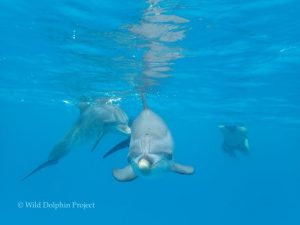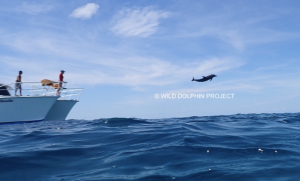How Families Can Help Save Wild Dolphins in 2025: Simple Actions for Big Impact
Dolphins are fascinating creatures, known for their intelligence and social behaviors, which we at the Wild Dolphin Project, led by Dr. Denise Herzing, love to study. But they face growing threats from noise pollution, marine debris and entanglement, changes in food availability and climate change — to name a few.
For example, over our 40 years of research at our study site, we’ve documented how a collapse in the local food web led to a mass exodus of dolphins from the population. Many of these dolphins relocated about 100 miles south. This shift in behavior highlights the complex relationship between dolphins and their environment, and we have been monitoring the impacts from that move closely. (read the study here).
While most of our work to help save dolphins involves research on behavior and communication, there are plenty of things families, including kids, can do to help. You don’t have to be a scientist! By making a few changes at home and getting involved in local efforts, families can play a significant role in saving wild dolphins.

1. Support Dolphin Conservation
One of the most effective ways to help wild dolphins is by supporting organizations like the Wild Dolphin Project. Donations fund research, education, and efforts to protect dolphin populations and their natural environments. This kind of support is critical to the ongoing work of scientists studying dolphin behavior and developing conservation strategies.
Families can make donations together, and this also provides a chance to talk to kids about the importance of supporting causes that protect animals and the environment. Many organizations offer educational materials, making it a great learning opportunity for young people. You can also gift memberships or symbolically adopt an animal at some organizations.
How you can help:
- Donate to the Wild Dolphin Project or other dolphin conservation organizations.
- Get involved in fundraising events or community activities to raise money for dolphin protection.
Learn how to help support WDP here.

2. Join or Organize Beach Cleanups
Plastic waste and trash are a serious threat to marine life, including dolphins. Dolphins can ingest plastic or become entangled in debris, which can lead to injury or death. We’ve seen many dolphins playing with plastic — especially young ones. While we feel guilty taking a “toy” from them, we know it’s best for their health and well-being.
Participating in or organizing a beach cleanup is a direct way to help keep the oceans clean and reduce pollution.Beach cleanups also give kids the chance to see the kind of pollution that affects marine life, recognize pollution from their daily lives (such as plastic pouch tops and plastic utensils, beach toys) and learn how they can make a difference. These activities can spark discussions about environmental issues and inspire kids to take action in other ways.
How you can help:
- Join or organize a local beach cleanup in your area.
- Encourage children to take part and teach them why it’s important to keep beaches and oceans clean.
3. Reduce Plastic Use in Daily Life
Plastic is one of the biggest threats to ocean life, including dolphins. Items like plastic bags, bottles, and straws are often carelessly discarded and end up in the ocean, where they can harm marine animals. Families can make a big difference by reducing plastic use in their everyday lives.
Switching to reusable items—like water bottles, grocery bags, and food containers—helps reduce the amount of plastic that ends up in landfills and the ocean. Teaching kids about the importance of using fewer disposable plastics can also help them develop long-term habits that protect the environment.
Birthday parties are a time for celebration, but they also present an opportunity to teach kids the importance of being mindful of the environment. Hosting an eco-friendly birthday party doesn’t mean sacrificing fun; in fact, it can make the event even more memorable. By making a few thoughtful choices—such as opting for sustainable materials, reducing waste, and using natural decorations or repurposing stuff found from stuff around the house— like old cardboard boxes—you can show your kids how easy it is to celebrate in a way that’s good for the planet.
How you can help:
- Use reusable bags, water bottles, and containers.
- Avoid single-use plastics like straws and encourage others to do the same.
- Recycle and compost whenever possible to reduce waste.
4. Choose Sustainable Seafood
Dolphins rely on healthy ecosystems and fish and squid populations to thrive. However, overfishing, bycatch, and unsustainable fishing practices threaten the balance of marine ecosystems. By choosing sustainable seafood, you can help protect the dolphins’ food source and ensure that fish populations remain abundant for generations to come.
Families can educate themselves about sustainable seafood options through resources like the Marine Stewardship Council (MSC) or Seafood Watch. Supporting fisheries that use sustainable practices helps reduce the impact of overfishing and protects the marine environment.
How you can help:
- Buy seafood certified by sustainability programs, such as MSC.
- Avoid purchasing fish from endangered species or from sources that contribute to overfishing.
- Educate children about the importance of protecting marine life by choosing sustainable seafood options.
5. Be Mindful of Beauty, Household Products and Toys
Many common beauty products and household cleaners contain harmful chemicals that eventually make their way into the ocean, affecting marine life. Families can make eco-conscious choices by selecting products with natural ingredients that are safe for dolphins and other wildlife. Studies (read here) have shown how preservatives from beauty products have even reached and build-up in tissue of Arctic mammals. There are numerous brands that offer safe, sustainable options for everything from skincare to cleaning supplies.
In addition to switching products, families can also reduce the frequency of purchasing new items. For example, by reusing toys and rethinking purchases, families can limit their contribution to environmental waste.
How you can help:
- Switch to eco-friendly, cruelty-free beauty and cleaning products.
- Choose natural, biodegradable ingredients and avoid products with harmful chemicals.
- Reuse toys and household items whenever possible, and choose secondhand options.
6. Support Dolphin-Friendly Tourism
If your family enjoys visiting coastal areas or marine environments, consider supporting tourism businesses that prioritize dolphin protection and eco-friendly practices. Many tour operators now offer dolphin-watching trips that respect wildlife and do their best not to disturb the animals’ natural behavior. These tours often educate participants about the importance of conservation and the threats dolphins face, helping to raise awareness for future generations. Some operators even collaborate with scientists by sharing photos for photo-identification of animals, such as orcas in the Pacific Northwest or humpback whales.
In many coastal areas, you can also enjoy wildlife viewing from the beach or cliffs. Whether it’s grey whales migrating along the California and Oregon coasts or dolphins cruising through the waters of the Carolinas and Georgia, there are plenty of opportunities to observe these animals in their natural habitats.
Seeing wildlife in its natural habitat is a powerful way to spark a passion for learning more about these animals and the environment foster a deeper connection and a desire to protect it.
How you can help:
- Choose responsible, eco-friendly dolphin watching tours.
- Support tourism businesses that follow ethical and sustainable practices.
- Teach children about the importance of respecting wildlife and the natural world.
- Watch wildlife in the wild
7. Teach and Inspire the Next Generation
Finally, one of the most powerful ways to support wild dolphins is by educating the next generation. Engage your children in learning about dolphins, their ecosystems, and the challenges they face. Read books, watch documentaries, visit museums and nature centers and encourage them to share this knowledge with friends and family, helping to create a ripple effect of awareness and action.
Instilling a love for wildlife and a commitment to conservation in children at an early age helps shape the next generation of environmental stewards. Whether they grow up to be scientists, conservationists, artists, or ocean advocates in some other way, these children will carry forward the work of protecting dolphins and their habitats.
How you can help:
- Use online resources, books, and documentaries to educate your children about dolphins.
- Encourage your kids to take part in school or community projects focused on wildlife conservation.
- Share your passion for conservation with others to inspire collective action.

Conclusion
Protecting wild dolphins is a cause that requires effort from all corners of society. Families can play a pivotal role in preserving marine mammals by making conscious choices, supporting conservation efforts, and instilling environmental values in future generations. From donating to beach cleanups, reducing plastic use, choosing sustainable seafood, to supporting eco-friendly products, there are countless ways families can contribute to dolphin conservation.
And if you can, join Wild Dolphin Project on a trip to view dolphins in the wild and learn directly from the scientists who have studied them for decades! It’s a unique opportunity to observe these aquatic creatures while gaining insights from experts.
More Resources:
The Wild Dolphin Project played a key role in the rescue and rehabilitation of a stranded dolphin named Cutter in the Florida Keys. After his recovery, WDP helped successfully return Cutter back into the wild, and we were proud to be part of this important effort. You can watch the Schoolyard Films documentary, A Dolphin’s Return, to learn more about his rescue and release
Read our scientific publications here.
